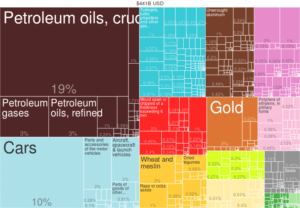
Since the early 20th century, the growth of Canada’s manufacturing, mining, and service sectors has transformed the nation from a largely rural economy to an urbanized, industrial one. Like many other developed countries, the Canadian economy is dominated by the service industry, which employs about three-quarters of the country’s workforce. However, Canada is unusual among developed countries in the importance of its primary sector, in which the forestry and petroleum industries are two of the most prominent components.
Canada is one of the few developed nations that are net exporters of energy. Atlantic Canada possesses vast offshore deposits of natural gas, and Alberta also hosts large oil and gas resources. The vastness of the Athabasca oil sands and other assets results in Canada having a 13% share of global oil reserves, comprising the world’s third-largest share after Venezuela and Saudi Arabia. Canada is additionally one of the world’s largest suppliers of agricultural products; the Canadian Prairies are one of the most important global producers of wheat, canola, and other grains. Canada’s Department of Natural Resources provides statistics regarding its major exports; the country is a leading exporter of zinc, uranium, gold, nickel, aluminum, steel, iron ore, coking coal and lead. Many towns in northern Canada, where agriculture is difficult, are sustainable because of nearby mines or sources of timber. Canada also has a sizeable manufacturing sector centred in southern Ontario and Quebec, with automobiles and aeronautics representing particularly important industries.
Transportation:
Transportation in Canada, the world’s second-largest country in total area, is dedicated to having an efficient, high-capacity multi modal transport spanning often vast distances between natural resource extraction sites, agricultural and urban areas. Canada’s transportation system includes more than 870,000 miles of roads, 10 major international airports, 300 smaller airports, 44,797 miles of functioning railway track, and more than 300 commercial ports and harbors that provide access to the Pacific, Atlantic and Arctic oceans as well as the Great Lakes and the St. Lawrence Seaway.
Transport Canada oversees and regulates most aspects of transportation within federal jurisdiction, including inter-provincial transport. This primarily includes rail, air and maritime transportation. Transport Canada is under the direction of the federal government’s Minister of Transport. The Transportation Safety Board of Canada is responsible for maintaining transportation safety in Canada by investigating accidents and making safety recommendations.
Roads:
There is a total of 647,700 miles of roads in Canada, of which 258,200 miles are paved, including 11,000 miles of expressways.

Air:
Air transportation made up 9% of the transport sector’s GDP generation in 2005.

Canada’s largest air carrier and its flag carrier is Air Canada, which had 34 million customers in 2006 and, as of April 2010, operates 363 aircraft (including Air Canada Jazz). CHC Helicopter, the largest commercial helicopter operator in the world, is second with 142 aircraft and WestJet, a low-cost carrier formed in 1996, is third with 100 aircraft. Canada’s airline industry saw significant change following the signing of the US-Canada open skies agreement in 1995, when the marketplace became less regulated and more competitive.
